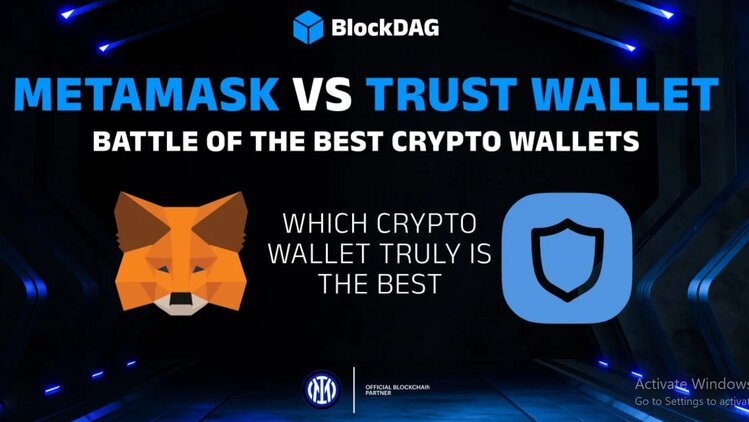other

August 05,2025 • 4 min read
MetaMask Vs Trust Wallet: Battle of the Best Crypto Wallets

1. Introduction: The Rise of Non-Custodial Wallets
With the rise of cryptocurrencies and decentralized finance (DeFi), non-custodial wallets have become a crucial tool for millions of users worldwide. These wallets provide complete control over digital assets, unlike custodial solutions that rely on third parties. Among the most popular non-custodial wallets are MetaMask and Trust Wallet—both offering secure, efficient, and feature-rich platforms for managing cryptocurrencies, interacting with dApps, staking, and trading tokens. In this blog, we will explore the key differences and similarities between these two wallet metamask vs trust wallet giants to help users choose the one that best fits their needs.
2. MetaMask Vs Trust Wallet: Quick Overview of Key Differences
Although both wallets are free and non-custodial, they differ in terms of blockchain compatibility, NFT handling, dApp interaction, and staking features. Let’s compare them across the most important factors.
3. Blockchain Compatibility
MetaMask started as an Ethereum-only wallet and later expanded to support EVM-compatible chains like Binance Smart Chain and Polygon. However, users must manually configure these networks, which may not be ideal for beginners.
Trust Wallet, on the other hand, comes preloaded with multiple blockchains such as Ethereum, Solana, Binance Chain, and other Layer-1 protocols. This plug-and-play flexibility makes it more convenient for users who frequently work with diverse networks.
4. Token Swapping Capabilities
Both MetaMask and Trust Wallet integrate token swap features directly into their interfaces.
MetaMask primarily supports Ethereum-based token swaps but integrates swap features within its extension and mobile app.
Trust Wallet supports token swapping on multiple networks including Binance Smart Chain (BSC), offering slightly broader functionality in terms of supported networks.
5. NFT Handling
Handling NFTs is becoming a major feature for any crypto wallet.
MetaMask supports Ethereum-based NFTs but its user interface is limited when it comes to managing NFTs from other chains.
Trust Wallet provides a more robust NFT experience by supporting multiple blockchain networks, making it easier for users to manage collections across different ecosystems.
6. dApp Browsing and Integration
Interacting with decentralized applications is a core feature of any Web3 wallet.
MetaMask is well known for its browser extension, making it a go-to choice for desktop users accessing DeFi apps. It also offers a mobile dApp browser.
Trust Wallet matches this with its own desktop extension and built-in mobile browser, allowing users to interact with dApps seamlessly from their phones or desktops.
7. Staking Opportunities
Staking is a vital tool for earning passive income in crypto.
Trust Wallet offers native staking support for multiple assets like BNB, XTZ, and more, making it easy to stake directly from the app.
MetaMask has added staking options recently, particularly focused on Ethereum-based assets, including liquid and validator staking. However, it still lacks the variety and simplicity that Trust Wallet offers.
8. Security Features
Security is a top priority in the crypto world.
Both MetaMask and Trust Wallet are non-custodial and open-source, giving users full control over their private keys. They also face similar risks—especially phishing attacks—mainly due to user error. The wallets themselves are secure, but it is up to users to follow best practices like using hardware wallets, avoiding suspicious links, and enabling biometric authentication.
9. User Experience and Ease of Use
MetaMask is simple and widely adopted, especially among Ethereum users, but adding other blockchains requires manual steps. This can be confusing for newcomers.
Trust Wallet offers a smoother multi-chain experience with automatic support for several blockchains, making it more beginner-friendly.
10. Transaction Costs
Transaction costs depend mostly on the blockchain being used and network congestion.
Both wallets apply standard gas fees and a small charge for swaps through their integrated exchange services. In practice, there is no significant cost difference between them.
11. Which Wallet Should You Choose?
Choosing between MetaMask and Trust Wallet depends on your specific needs.
Choose MetaMask if:
-
You’re focused on Ethereum-based DeFi
-
You prefer interacting with dApps on a desktop browser
-
You’re comfortable manually configuring networks
Choose Trust Wallet if: -
You frequently use multiple blockchain networks
-
You prefer managing NFTs across chains
-
You want built-in staking and an easy mobile experience
Both wallets are reliable, secure, and widely supported. The decision ultimately depends on how you interact with the blockchain ecosystem.
12. The Future Beyond Wallets: Introducing BlockDAG
While crypto wallets are essential for managing digital assets, the next wave of innovation is already making waves—enter BlockDAG. As a hybrid between blockchain and Directed Acyclic Graph (DAG) structures, BlockDAG is reshaping how decentralized systems operate.
One of the standout reasons BlockDAG is gaining attention is its hybrid model that merges the transparency of blockchain with the scalability of DAG. This architecture allows faster transaction speeds, lower fees, and better network efficiency—features that appeal to both users and institutional investors.
Falkner Wilson Details
User Profile
- Full name
- Falkner Wilson
- Email address
- falknerwilson0@gmail.com
- Join Date
- 2025-08-05
- State
- City
- Pincode
- Address
- Follow us on Facebook
- Follow us on Twitter
- Website Name
- Bio